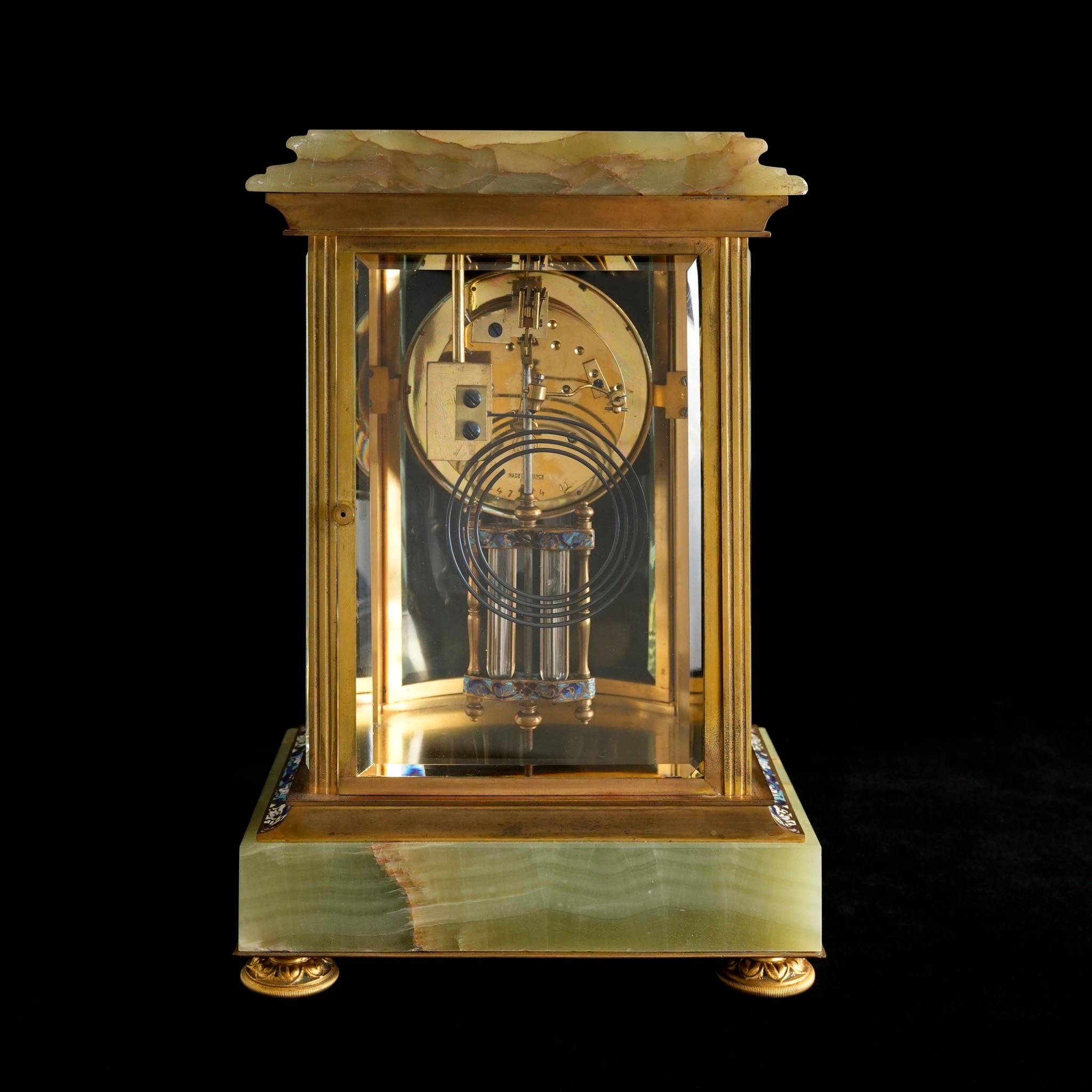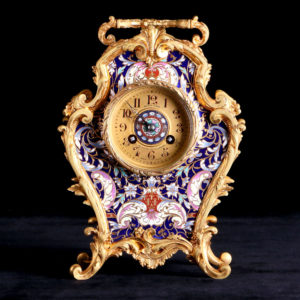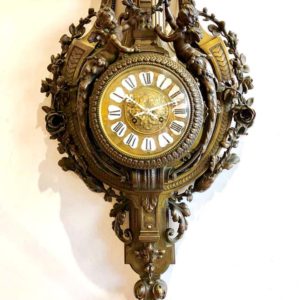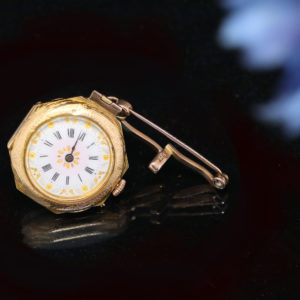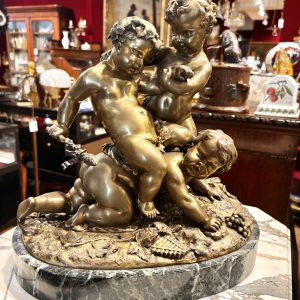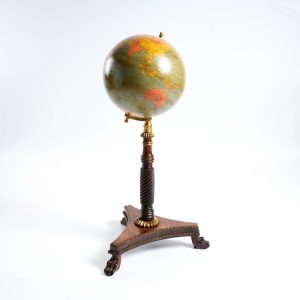描述
鎏金技術介紹:
鎏金Ormolu是法文,其作法簡單說明是把金子和水銀合成“金汞齊”﹐將“金汞齊”塗在要鎏金的物體表面﹐加溫至極熱的溫度後使水銀蒸發,只剩下K金留在銅表面而不脫落,其金色光澤性能夠永久維持。而因為汞加熱後揮發的氣體有毒性,所以使用汞來執行鎏金的技術,在1900-1910年左右,就被法國政府所明文禁止使用,所以之後鎏金座鐘數量驟減,只剩少數訂製品。至此之後任何一種技術,包括現今常見的電鍍技術,都沒有辦法超越銅鎏金所呈現出來的美感,因為電鍍的電鍍成色較為冷感,金屬質感較重; 電鍍金不是真金,是利用電解原理在物體表面鋪上類似金色的金屬,經過一段時間顏色會褪,不若鎏金的技術所呈現出來的K金質感,是色澤飽和的黃金色系,而且可以歷久彌新。
Cloisonné技法介紹
Cloisonné是最古老的、廣為人知的琺瑯畫技法之一,經常在金器或是貴重金屬飾品裡見到。Cloisonné的法文原意為「分開」或是「分離」,而他的做法也就跟這意思一樣。簡單的來說,Cloisonné技法大致分為三個步驟。首先,再欲上色金屬表面上的平放間隔金屬片條,可能是純金、純銀或是青銅黃銅等其他貴金屬,並將這些金屬片條焊在其表面。而這些金屬片條也就形成了一個圖案的外線條並作為阻擋物將每個不同區塊的顏料分開來。接下來,這些圖案區塊就被分別的用手繪的方式填上琺瑯顏料,並在同時放上欲鑲嵌寶石或是貴重石頭作為裝飾。最後整個表面經過窯爐加熱至熔點,在冷卻後用浮石打磨至其散發光澤。目前已知最早的Cloisonné技法出現在古希臘時代,而在中世紀的歐洲基督教國家、東歐或是伊斯蘭國家,以及拜占庭、東羅馬帝國等等都有出現過。另外Cloisonné技法也傳到了亞洲地區,在中國的明朝與清朝時期都有這類技法的出現。而日本則是出現在江戶和明治時代,在當時的工匠技法是相當的流行。在之後Cloisonné更被開發出了更多樣的技術,例如工匠們先暫時性的將金屬條放上,等待琺瑯顏料冷卻後再將金屬條取出,藉以達成不同的效果。羅馬藝術的演變裡可以看出Cloisonné技法也是漸漸地被工匠們開發、演變成不一樣的技術。例如Champlevé技法不使用金屬條,而是在凹槽圖樣上作畫。
製錶公司介紹:
Frédéric Japy (1749-1812) was a pioneer in the industrialization of not only clocks, but of manufacturing in general. An imaginative inventor of all sorts of machines, he began his career as a watchmaker.
The son of Jacques Japy (1699-1781) and Marie Marguerite Fainot (1745-1797), Frédéric Japy was born on May 22, 1749 at Beaucourt , a small village at the end of the principality of Montbéliard . One of the wealthiest families in Beaucourt.
Frédéric Japy was apprenticed by Jacques Georges Frédéric Japy, his grandfather, in the profession of watchmaker in Montbeliard. At age 17, he returned to Beaucourt to spend two years working in the workshop of his father.
At that time, watch and clock parts were manufactured usually by hand by specialized workers in their homes in small communities. The parts were then collected and mounted into a piece by an ‘assembler’. Once the movement was assembled, it was then sent to a ‘dresser’ who would in turn mount it into a case – be it a small one or an elaborate brass plated mantle clock complete with mythological figures.
Frederic Japy purchased some of few clock making machines in existence, brought them back to his native town of Beaucourt and proceeded to invent new ones in order to standardize the pieces and the quality of the production.
The workers were then regrouped into one location instead of being scattered throughout the countryside and each one was assigned to a specific work post with its own specific machine. Frederic Japy radically changed the way clocks were produced. The sequential production of parts in one location – a manufacturing plant – aided by machines meant that clock parts were made and assembled in about half the time that it had taken previously.
Japy then imagined other applications (and invented the machines required to produce them) such as the mass production of hardware parts (screws, nails, bolts) and other products – rotating pumps (a model still in use today), locks, and he perfected the creation and baking of enamelware.
In clockmaking – Japy’s enamel dials became the standard for the great majority of clock manufacturers for 150 years both in France and abroad. There are few French carriage clocks in existence that do not have Japy enamel dials on them.
Japy’s plants continued to produce clocks in many styles and at the higher priced levels. In 1806, he handed the direction of his businesses to his three sons – and it became Japy Frères (Japy Brothers) who, in turn, diversified the manufacturing to produce coffee grinders, typewriters, enamelware, kitchen utensils, office machines such as the first typewriters, refrigerator pumps, advertising signs and they invented more machines to transform copper and steel wires into elaborate hardware parts.
However, his sons’ sons did not inherit the creative and inventive spirit of their fathers and grandfather and by the early 1900’s, many of the the businesses were sold off and the manufacturing was dismantled.
Frédéric Japy (1749-1812)不僅是鐘錶業,是多種產業的先鋒。他起始於鐘錶事業,是一位極具創造力的發明家。
他是Jacques Japy (1699-1781) and Marie Marguerite Fainot (1745-1797)的兒子。於1749年5月22日在Beaucourt出生,是靠近Montbéliard的一個小村落。他出生於一個富裕的家庭。
他在他祖父底下做學徒,他祖父在Montbeliard是一位專業的鐘錶匠,在17歲時他回到Beaucourt花了兩年的時間在父親的工作室底下工作。
在當時,鐘和錶的零件通常都是由特殊專業的工匠在家勇手工方式製成,然後再由一位負責組合的工匠(assembler),將所有零件收集並整合在一起,一旦完成組裝的工作,便會送到另外一個專責的工匠(dresser)將這些機芯構造放入機殼當中,有些是小的機殼,有些是有鍍金或帶有神話浮雕的機殼。
Frederic Japy買下了當時現存的為數不多的製錶機器,帶回他的出生地Beaucourt並開始加速發明新的機器,以便進行標準化及品質化的製作生產作業。
所有的製錶工人被集中在同一處工作,而不是像以往一樣四散各地、各自執行工作。他改成了鐘錶製作的流程。在同一處連續製作的流程-工廠的雛型,藉由機器的輔助,製作和組裝的時間比以往少了一半。
接下來他又發展出新的機具來生產出其他新開發的零件,如大量製作螺絲、螺帽和釘子等,還有如改造迴轉泵,其模型仍沿用至今。
在時鐘製作部分,他所發明的琺瑯錶盤成為法國和其他國家的主要時鐘製造商的標準配備長達150年,現存的法國旅行座鐘當中,只有極少數沒有使用他所發明的琺瑯錶盤。
他的工廠持續製作各種不同類型的時鐘,而且都是高單價檔次的時鐘。在1806年改由他的三個兒子來決定事業體的走向,公司變成為Japy Frères (Japy Brothers),開始改而生產磨豆機、打字機、琺瑯製品、廚房用品和辦公設備,因而發明出第一台打字機、冰箱泵和廣告招牌,他們發明更多的機具來將銅和鋼轉化為更細緻的套件。
然而他的孫子輩並沒有遺傳到其父親和祖父的創造力和發明精神,在1900年初期,多數事業體已經被賣掉或解散了。
石材介紹:
Onyx is a stone that appears in various cultures and it is still highly regarded one of the most popular gemstones in the world even now. Onyx has long been a part of gemstone metaphysical theories and gemstone healing therapies for a long time. This stone is often turned into necklace, beads, charm and amulet and many more.
Onyx又稱為瑪瑙石是在世界各地不同的文化中都被認為是極受歡迎的一種寶石,整體外觀呈現類似玉石的質感,深受藏家的喜愛。





